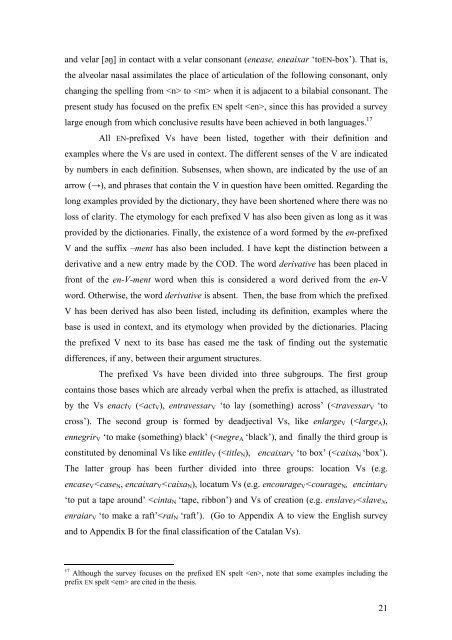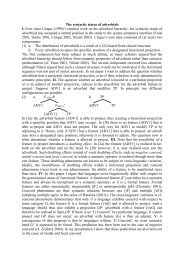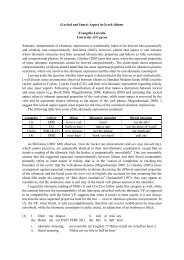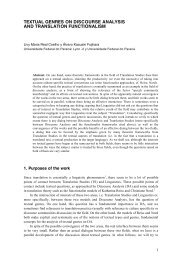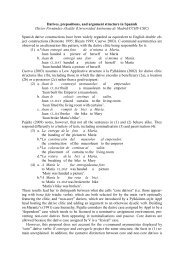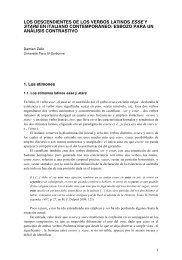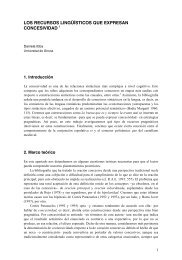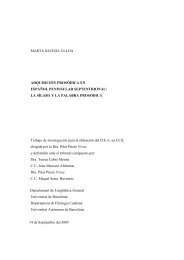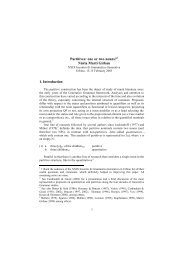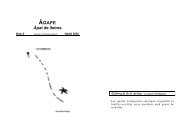Prefixation in English and Catalan - Departament de Filologia ...
Prefixation in English and Catalan - Departament de Filologia ...
Prefixation in English and Catalan - Departament de Filologia ...
Create successful ePaper yourself
Turn your PDF publications into a flip-book with our unique Google optimized e-Paper software.
<strong>and</strong> velar [əŋ] <strong>in</strong> contact with a velar consonant (encase, encaixar ‘toEN-box’). That is,<br />
the alveolar nasal assimilates the place of articulation of the follow<strong>in</strong>g consonant, only<br />
chang<strong>in</strong>g the spell<strong>in</strong>g from to when it is adjacent to a bilabial consonant. The<br />
present study has focused on the prefix EN spelt , s<strong>in</strong>ce this has provi<strong>de</strong>d a survey<br />
large enough from which conclusive results have been achieved <strong>in</strong> both languages. 17<br />
All EN-prefixed Vs have been listed, together with their <strong>de</strong>f<strong>in</strong>ition <strong>and</strong><br />
examples where the Vs are used <strong>in</strong> context. The different senses of the V are <strong>in</strong>dicated<br />
by numbers <strong>in</strong> each <strong>de</strong>f<strong>in</strong>ition. Subsenses, when shown, are <strong>in</strong>dicated by the use of an<br />
arrow (→), <strong>and</strong> phrases that conta<strong>in</strong> the V <strong>in</strong> question have been omitted. Regard<strong>in</strong>g the<br />
long examples provi<strong>de</strong>d by the dictionary, they have been shortened where there was no<br />
loss of clarity. The etymology for each prefixed V has also been given as long as it was<br />
provi<strong>de</strong>d by the dictionaries. F<strong>in</strong>ally, the existence of a word formed by the en-prefixed<br />
V <strong>and</strong> the suffix –ment has also been <strong>in</strong>clu<strong>de</strong>d. I have kept the dist<strong>in</strong>ction between a<br />
<strong>de</strong>rivative <strong>and</strong> a new entry ma<strong>de</strong> by the COD. The word <strong>de</strong>rivative has been placed <strong>in</strong><br />
front of the en-V-ment word when this is consi<strong>de</strong>red a word <strong>de</strong>rived from the en-V<br />
word. Otherwise, the word <strong>de</strong>rivative is absent. Then, the base from which the prefixed<br />
V has been <strong>de</strong>rived has also been listed, <strong>in</strong>clud<strong>in</strong>g its <strong>de</strong>f<strong>in</strong>ition, examples where the<br />
base is used <strong>in</strong> context, <strong>and</strong> its etymology when provi<strong>de</strong>d by the dictionaries. Plac<strong>in</strong>g<br />
the prefixed V next to its base has eased me the task of f<strong>in</strong>d<strong>in</strong>g out the systematic<br />
differences, if any, between their argument structures.<br />
The prefixed Vs have been divi<strong>de</strong>d <strong>in</strong>to three subgroups. The first group<br />
conta<strong>in</strong>s those bases which are already verbal when the prefix is attached, as illustrated<br />
by the Vs enactV (


